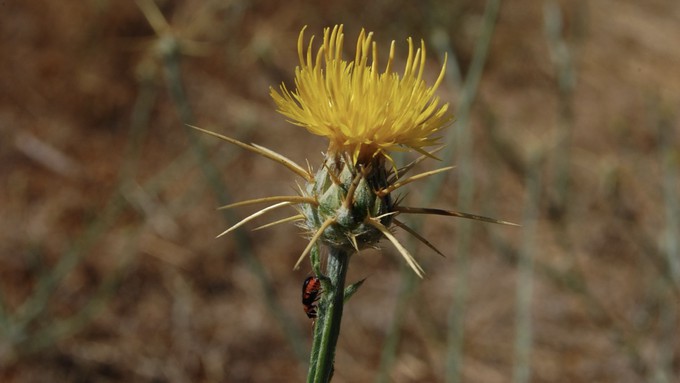
This invasive plant is toxic to horses; find out ways to control it

This spiky weed, the yellow starthistle, is invasive across California, and very dangerous to horses. Photo by Eugene Zelenko, courtesy of Wikimedia Commons
It’s prickly, invasive and can kill a horse. Those are just a few reasons yellow starthistle is considered such a bad weed.
Right now, this noxious plant is getting ready for another attack on California. A winter-growing annual, starthistle produces seed in September and October that sprouts with fall rain. Found in every county, starthistle is estimated to be the dominant plant across 15 million acres in California alone.
With deep taproots, starthistle seems impervious to many attempts at control. Yes, it does support pollinators (and makes delicious honey), but starthistle is toxic to horses – which makes it downright dangerous in pastures.
Learn ways to control starthistle -- before it’s too late -- in a free workshop, offered by the El Dorado County master gardeners.
Set for 9 a.m. to noon Saturday, Oct. 26, “Starthistle Management” will take a deep dive into this thorny subject with loads of practical information. The in-person class will be held at the Bethel-Delfino Ag Building in Placerville.
“Join Master Gardener Steve Savage to learn about this invasive weed that has taken over large portions of California’s range land and urban landscape,” say the master gardeners. “Learn about its origins, how it moves, why it is so difficult to control, how to overcome these difficulties, control methods, and how to design an effective control program.”
Native to the Mediterranean, yellow starthistle likely came to California (and the greater Sacramento area) in contaminated animal feed during the Gold Rush, say UC researchers. This weed loved the climate and quickly became a nuisance. It thrives where other plants struggle, such as compacted dirt along roadways.
No advance registration for the workshop is needed, although it is appreciated, say the master gardeners; space is limited. The Bethel-Delfino Ag Building is located at 311 Fair Lane, Placerville.
More details and registration link: https://mgeldorado.ucanr.edu/
Comments
0 comments have been posted.Sacramento Digs Gardening to your inbox.
Food in My Back Yard Series
April 29: What's (already) wrong with my tomato plants?
April 22: Should you stock up on fertilizer? (Yes!)
April 15: Grow culinary herbs in containers
April 8: When to plant summer vegetables
April 1: Don't be fooled by these garden myths
March 25: Fertilizer tips: How to 'feed' your vegetables for healthy growth
March 18: Time to give vegetable seedlings some more space
March 11: Ways to win the fight against weeds
March 4: Potatoes from the garden
Feb. 25: Plant a fruit tree now -- for later
Feb. 18: How to squeeze more food into less space
Feb. 11: When to plant? Consider staggering your transplants
Feb. 4: Starting in seed starting
Sites We Like
Garden Checklist for week of May 4
Enjoy this spring weather – and get gardening!
* Plant, plant, plant! It’s prime planting season in the Sacramento area. Time to set out those tomato transplants along with peppers and eggplants. Pinch off any flowers on new transplants to make them concentrate on establishing roots instead of setting premature fruit.
* Direct-seed melons, cucumbers, summer squash, corn, radishes, pumpkins and annual herbs such as basil.
* Harvest cabbage, lettuce, peas and green onions.
* In the flower garden, direct-seed sunflowers, cosmos, salvia, zinnias, marigolds, celosia and asters. (You also can transplant seedlings for many of the same flowers.)
* Plant dahlia tubers. Other perennials to set out include verbena, coreopsis, coneflower and astilbe.
* Transplant petunias, marigolds and perennial flowers such as astilbe, columbine, coneflowers, coreopsis, dahlias, rudbeckia and verbena.
* Keep an eye out for slugs, snails, earwigs and aphids that want to dine on tender new growth.
* Feed summer bloomers with a balanced fertilizer.
* For continued bloom, cut off spent flowers on roses as well as other flowering plants.
* Add mulch to the garden to maintain moisture. Mulch also cuts down on weeds. But don’t let it mound around the stems or trunks of trees or shrubs. Leave about a 6-inch to 1-foot circle to avoid crown rot or other problems.